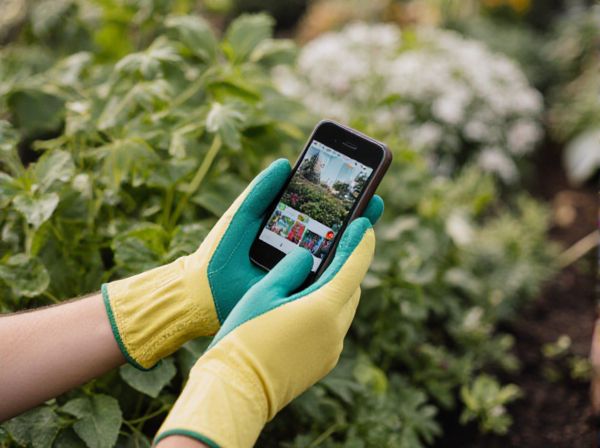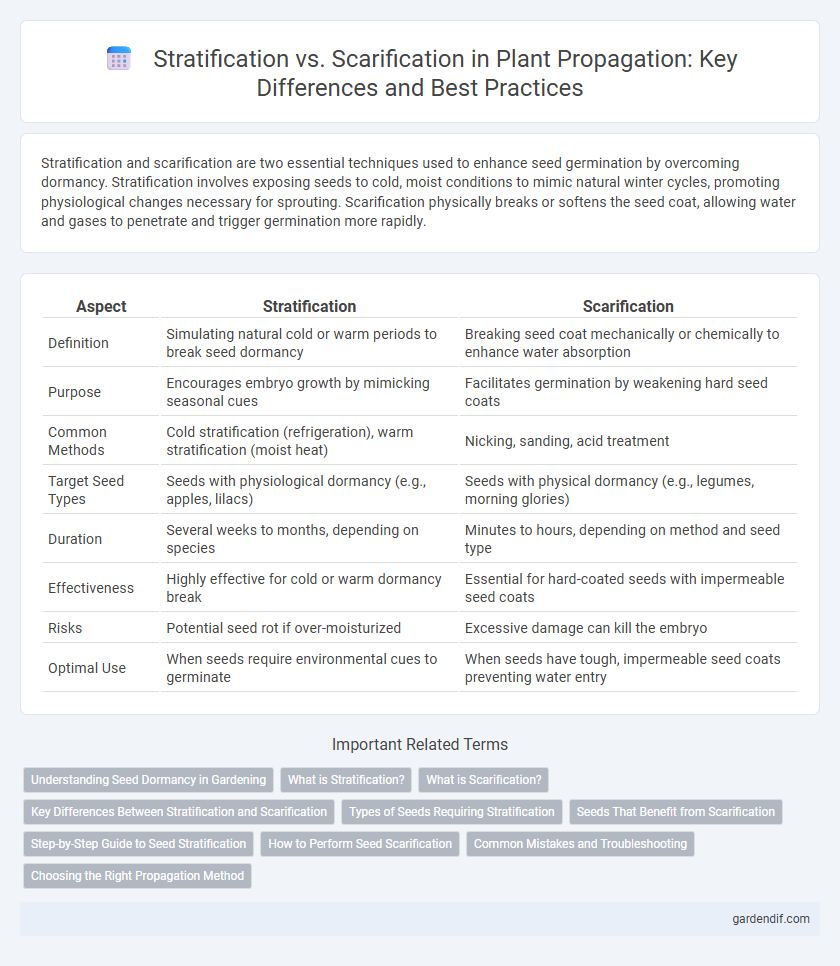
Stratification vs scarification Illustration
Stratification and scarification are two essential techniques used to enhance seed germination by overcoming dormancy. Stratification involves exposing seeds to cold, moist conditions to mimic natural winter cycles, promoting physiological changes necessary for sprouting. Scarification physically breaks or softens the seed coat, allowing water and gases to penetrate and trigger germination more rapidly.
Table of Comparison
| Aspect | Stratification | Scarification |
|---|---|---|
| Definition | Simulating natural cold or warm periods to break seed dormancy | Breaking seed coat mechanically or chemically to enhance water absorption |
| Purpose | Encourages embryo growth by mimicking seasonal cues | Facilitates germination by weakening hard seed coats |
| Common Methods | Cold stratification (refrigeration), warm stratification (moist heat) | Nicking, sanding, acid treatment |
| Target Seed Types | Seeds with physiological dormancy (e.g., apples, lilacs) | Seeds with physical dormancy (e.g., legumes, morning glories) |
| Duration | Several weeks to months, depending on species | Minutes to hours, depending on method and seed type |
| Effectiveness | Highly effective for cold or warm dormancy break | Essential for hard-coated seeds with impermeable seed coats |
| Risks | Potential seed rot if over-moisturized | Excessive damage can kill the embryo |
| Optimal Use | When seeds require environmental cues to germinate | When seeds have tough, impermeable seed coats preventing water entry |
Understanding Seed Dormancy in Gardening
Stratification and scarification are essential techniques for breaking seed dormancy, promoting successful germination in gardening. Stratification mimics natural cold winter conditions by exposing seeds to moist, low temperatures, which triggers physiological changes necessary for sprouting. Scarification involves physically or chemically weakening the seed coat to allow water and gases to penetrate, overcoming mechanical dormancy and facilitating growth.
What is Stratification?
Stratification is a seed propagation technique that mimics natural winter conditions by exposing seeds to cold and moist environments, breaking seed dormancy and promoting germination. This process is essential for many temperate species, such as apple, cherry, and oak, which require a period of cold stratification to successfully sprout. Unlike scarification, which physically breaks the seed coat, stratification relies on environmental cues to trigger internal physiological changes within the seed.
What is Scarification?
Scarification is a propagation technique used to break or weaken the hard outer seed coat to enhance water absorption and stimulate germination. This method involves mechanical abrasion, chemical treatment, or thermal exposure to overcome seed dormancy typically found in species like Acacia, Cassia, and lupines. Scarification improves germination rates by allowing oxygen and moisture to penetrate the seed coat more easily compared to untreated seeds.
Key Differences Between Stratification and Scarification
Stratification involves exposing seeds to cold or moist conditions to break dormancy and mimic natural environmental cues for germination, while scarification physically alters the seed coat to improve water absorption and gas exchange. Stratification typically requires controlled temperature and moisture over days or weeks, whereas scarification is a quicker process using mechanical, chemical, or thermal methods. These distinct techniques target different dormancy mechanisms, making their application dependent on the seed species and propagation goals.
Types of Seeds Requiring Stratification
Seeds requiring stratification primarily include those from temperate woody plants such as apple, cherry, and maple, which have a tough seed coat and physiological dormancy. These seeds need a period of cold, moist conditions to break dormancy and stimulate germination. In contrast, seeds needing scarification, like legumes and morning glories, require physical abrasion or chemical treatment to penetrate hard seed coats.
Seeds That Benefit from Scarification
Seeds that benefit from scarification typically have hard, impermeable seed coats that prevent water absorption and delay germination. Examples include tough seeds of species such as milkweed, scarlet runner beans, and morning glory, which respond well to mechanical or chemical scarification to break dormancy. Scarification increases germination rates by allowing moisture to penetrate the seed coat, making it an essential propagation technique for these types of seeds.
Step-by-Step Guide to Seed Stratification
Seed stratification involves mimicking natural winter conditions by exposing seeds to cold, moist environments, which breaks dormancy and promotes uniform germination. Begin by soaking seeds in water for 12-24 hours to rehydrate, then place them in a damp medium such as sand or peat moss inside a sealed bag or container, refrigerated at 1-5degC (34-41degF) for 4-12 weeks depending on the species. Regularly check moisture levels and avoid freezing temperatures to ensure optimal stratification effectiveness.
How to Perform Seed Scarification
Seed scarification involves physically or chemically breaking the hard seed coat to promote water absorption and accelerate germination. Common methods include sanding or nicking the seed coat with a file, soaking seeds in hot water for a specified duration, or treating seeds with acid solutions like sulfuric acid under controlled conditions. Proper scarification techniques vary by seed species and are crucial for ensuring successful propagation of hard-coated seeds such as those of legumes and certain tree species.
Common Mistakes and Troubleshooting
Common mistakes in propagation include confusing stratification and scarification, which serve different purposes: stratification mimics natural cold periods to break seed dormancy, while scarification physically breaks seed coats to enhance water absorption. Troubleshooting often involves improper timing or environmental conditions, such as insufficient cold duration for stratification or inadequate seed coat abrasion in scarification, leading to low germination rates. Ensuring optimal temperature, moisture levels, and precise technique improves propagation success with these seed treatment methods.
Choosing the Right Propagation Method
Selecting the appropriate propagation method depends on seed characteristics and growth goals; stratification mimics natural cold periods to break seed dormancy, ideal for temperate species with hard seed coats. Scarification involves physically or chemically breaking the seed coat to enhance water absorption, suitable for seeds with impermeable outer layers like legumes and some trees. Effective propagation requires understanding each seed's dormancy mechanisms to optimize germination rates and ensure successful plant development.
Stratification vs scarification Infographic

 gardendif.com
gardendif.com